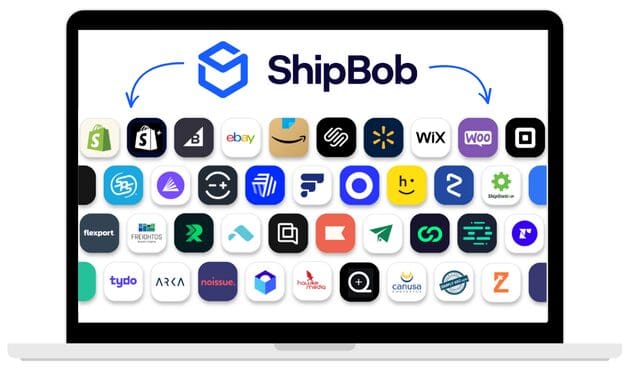With so many moving parts to running an ecommerce business, you’ll probably build a tech stack of several different apps, platforms, and solutions to power your operations.
You’ll want to select top performers in each area, as well as solutions that connect with each other seamlessly – but researching with so many options on the market, choosing can be time-consuming and tricky.
To help you select the right partners for your business, we’ve compiled a shortlist of the top 18 integrations across key supply ecommerce functions. We’ll also dive deep into how good integrations benefit your brand, and how to choose the best integrations for your business.
Top 18 ecommerce integrations for fulfilment success
Order processing integrations
1. Order Desk
Order Desk is an integration that helps you streamline and automate your order management operations. The software automatically pulls inventory data from your warehouse for a real-time stock count update across all your sales channels.
Its Rules Engine makes it easy to split orders, filter by country, add data before sending orders for fulfilment, and more. Order Desk integrates with 300+ services, allowing you to build a powerful ecommerce ecosystem.
2. Pipe17
Pipe17 lets you automate your omnichannel order flow by integrating all the key aspects of your ecommerce operations. Its hundreds of integrations encompass your selling, fulfilment, and even back-office ecommerce operations.
You can automatically process orders and route them to the most optimal fulfilment centre, allowing you to seamlessly fulfil orders various sales channels. Align your products and SKUs across different channels and manage your inventory effortlessly in one place.
3. Linnworks
Linnworks lets you manage your product listings for multi-channel ecommerce, empowering you to sell wherever your customers are. You can access your inventory levels in real-time across all these channels, so you see exactly what you have in stock. Manage and process sales from all your ecommerce stores and marketplaces in one place to centralise your operations.
Inventory management integrations
4. Inventory Planner
Inventory Planner helps you optimise your inventory purchasing operations with accurate forecasting and replenishment recommendations. It allows you to create custom forecasting for seasonal or trendy items and high-demand products, so you can prioritize replenishment accordingly and even get low-stock alerts for items.
Its Open-to-Buy (OTB) planning feature helps you plan your cash flow and inventory purchases according to your purchasing budget. You can also easily manage your replenishments with the ability to email vendors directly from the platform and create purchase orders based on your forecast.
5. Cin7
Cin7 gives you full visibility into your inventory levels across all your ecommerce warehouses. This allows you to centralise your inventory management while maintaining accurate inventory data even as you sell, buy, or move stock between different locations.
The platform integrates all your channels and locations in one solution, allowing for automatic data updates. This reduces the need for manual entry, ensuring better inventory accuracy.
6. QuickBooks Inventory Management
The QuickBooks Inventory Management system lets you track your stock levels in real-time and auto-updates your inventory. It connects with Shopify, eBay, and other sales channels, as well as paument portals like PayPal. This ensures that your inventory value is also updated in real-time, making it easier to maintain your balance sheet.
The system lets you keep track of what you’ve ordered from each supplier, and gives you low-stock alerts so you know when to reorder inventory. After inventory arrives, the purchase order is converted into an account to ensure timely supplier payments.
Payment gateway integrations
7. Stripe
Stripe is a leading payment process that integrates with all the major ecommerce platforms. It gives you access to 100+ payment methods and lets you present in local currencies. This makes it easy to accept payments across different online sales channels around the world. Optimise the customer experience with conversion-optimised checkout pages designed to streamline the purchase process.
8. PayPal
PayPal is a popular payment system that allows you to create a seamless buying experience. You can accept payments from 200+ markets and offer the flexibility to use multiple payment methods. This includes options like buy now, pay later, and recurring payments or subscriptions. Offer local payment options in 100+ currencies and expand your business globally.
9. Square
Square is a point-of-sale integration that streamlines payments for all your online and offline commerce platforms. Create a seamless checkout experience with multiple payment options including credit cards, debit cards, mobile wallet payments, installment payments, and even ACH bank transfers.
Customer service and CRM integrations
10. HubSpot
HubSpot is a customer relationship management (CRM) system that lets you manage all your customer communications in a single universal inbox. This allows you to better support your customers with live chat and ticketing tools to manage and organise your communications. Access detailed records on every contact to add context to each interaction and provide a helpful response every time.
11. Salesforce CRM
Salesforce offers a comprehensive suite of CRM platforms to support various aspects of your ecommerce operations, including sales, marketing, and service. The Service Cloud equips your human agents with powerful customer service and AI tools to manage your customer support inquiries. Manage interactions, cases, and incidents centrally and automate routine tasks to take your ecommerce customer experience to the next level.
12. Zendesk
Zendesk is a leading customer service platform that manages your omnichannel communications. This commerce integration lets you seamlessly interact with your ecommerce customers through their preferred channels, including email, phone, live chat, and even social media. It comes with AI tools and workflow automation to help agents solve customer issues faster.
13. Klaviyo
Klaviyo is a unified platform to manage all your customer communications in one place, including email marketing, SMS, and more. With direct ownership of your customer data, the platform helps you personalise customer interactions and troubleshot quickly. Integrate it with real-time fulfilment and inventory data to send order-specific updates and enhance your post-purchase communications.
14. Gorgias
Gorgias is an ecommerce helpdesk that lets you manage all your customer support in one place. Integrate your order and customer data from your fulfilment solution (like ShipBob) into the platform and get real-time visibility into where customer orders are at any stage of the ecommerce fulfilment process. Get automated alerts when orders are on hold or in exception, so your team can manage expectations and minimise frustrations.
15. Triple Whale
Triple Whale is a data integration platform to help you maintain a single source of truth for all your ecommerce data. Bring together all the metrics you need in one place to inform your decisions and strategies. Use AI to make sense of the data and build accurate forecasts for increased profitability
Shipping and logistics integrations
16. ShipBob
ShipBob is an expert omnifulfillment partner, offering powerful fulfilment software that integrates with leading ecommerce tools to streamline your shipping and logistics operations. You can outsource inventory storage, picking, packing, and shipping to ShipBob to optimise your operations for accuracy and efficiency while achieving cost-savings and getting time back.
ShipBob also offers solutions for 2-day shipping, intelligent inventory distribution, B2B and marketplace fulfilment, analytics and reporting, and even a warehouse management system to power fulfilment in-house, making it much more than just a shipping platform.
17. FedEx
FedEx’s multinational courier delivery service helps you seamlessly ship out your ecommerce orders across the globe. Use the company’s integrations with various ecommerce apps to compare ship options, estimate shipping fees, and get real-time shipment tracking data for your last-mile deliveries.
18. UPS
UPS connects with leading ecommerce websites and platforms for integrated logistics. These integrations make it easy to coordinate your shipment and delivery, compare shipping options, and estimate your shipping costs in one place. Generate shipping labels and track your shipments in one place with a UPS integration.
How ecommerce integrations scale fulfilment
Seamless integration of multiple tools is particularly important in ecommerce fulfilment. Efficient fulfilment requires information and goods to flow between any and all tools or platforms you use, so it’s incredibly important that all your integrations work correctly. Otherwise, you may experience bottlenecks in your supply chain management, extended lead times and delays, and even potentially lost orders and revenue.
When your fulfilment tech stack is all integrated, data easily syncs across your systems, providing every tool with the information it needs to run when it needs it. This not only prevents hiccups that delay operations, but also delivers some great benefits.

Benefits of ecommerce integrations
Streamlines your ecommerce operations
Integrations allow different processes to work together smoothly, and save you the trouble of toggling back and forth between multiple tools to accomplish one task.
For instance, by integrating your ecommerce website with your inventory management system, every time someone places an order on your ecommerce website, the integration transfers that information directly to your inventory management system so that inventory counts are updated automatically. This saves you the hassle of having to manually check or adjust stock counts every time someone places an order.
In this way, good integrations make your operations more efficient and give you time back to focus on other priorities.
Reduces manual work with improved automation
Integrations automate a lot of information transfer across platforms, without you having to manually input data from one system into another.
For example, integrating your shipping software with marketing automation tools like Mailchimp will let you automatically send shipping update emails to your customers. That way, your human agents won’t have to manually check the shipping software to track packages and manually send email updates.
This not only saves you time and effort, but also makes the data transfer more accurate (as it reduces the risk of human error).
Ensures real-time data accuracy
When your ecommerce data is automatically synced between systems, you can get the information you need more quickly – often in real time. This automated data exchange significantly improves efficiency, enabling you to make quick, informed, and often automatic decisions.
For example, say you’ve integrated your ecommerce storefront and your inventory management software. Because your IMS feeds stock level data back to your website, this means that your IMS can update product listings automatically to list them as “sold out” when you have no more stock left to prevent overselling and backorders.
Delivers seamless omnichannel customer experiences
Ecommerce integrations allow you to connect all your ecommerce sales channels and customer touchpoints to deliver a seamless omnichannel experience. With comprehensive visibility into your inventory, orders, shipping, and customer data, you are better equipped to manage multiple channels and fulfilment locations, and provide a consistent purchasing and delivery experience to all customers.
For example, when your customer care team can view real-time order updates, they can provide customers with information on order status and estimated delivery timelines. Similarly, having your inventory and order management tools integrated will allow you to monitor inventory levels and order volume across channels, so that you don’t accidentally sell inventory to customers on one channel that you’ve already promised to customers on a different channel.
How to choose the right ecommerce integration solution
When selecting ecommerce solutions for your business, it’s important to take a strategic approach so you’re making the right investment. Here are some tips for building your ecommerce tech stack for maximum connectivity and seamless integrations.

Assess your ecommerce platform compatibility
Your ecommerce website platform is the cornerstone of your entire business, so it stands to reason that you should build your tech stack around it. This means that any platform or tool you leverage for other ecommerce functions (such as inventory management, order management, warehouse management, etc.).
Many solutions are compatible with leading platforms like Shopify, WooCommerce, and BigCommerce. However, integration with every platform is not guaranteed, especially with smaller, lesser-known tools – so be sure to check the full list of compatible platforms and see if the tool supports integration with your particular ecommerce platform.

Avoid common integration pitfalls
When setting up integrations, many online businesses experience the same sorts of challenges, including:
- Outdated systems or software
- Issues with data syncing across platforms
- High costs (especially when building an integration from scratch)
To avoid these pitfalls, specifically check each potential tool or platform’s compatibility with your existing systems, and how much an integration would cost. Look at reviews and demos, and consider free trials to perform a thorough assessment of each platform before investing in it.
Once you’ve committed to a tool or platform, make sure that you are using the most up-to-date versions of each tool and system you want to integrate. If the partner offers specialized support or onboarding help, leverage their expertise to resolve issues with data syncing or speed.

Consider scalability for your business
Scalability is another key consideration when choosing an ecommerce integration. Even if a system supports your current channels and geographies, consider whether it can continue to do so a few years down the line – and if it will work with additional channels that you may need to leverage in the future.
To avoid having to go through the same trouble of searching for and integrating a new solution in just a few years, make sure the solution offers every capability you’d want to leverage as you grow.

Compare pricing and consider total cost of ownership
One of the most important considerations is the cost of an ecommerce integration. While the upfront costs are easier to compare, long-term pricing models like subscription-based services could add to the total cost. Similarly, if you plan to upgrade service tiers or add additional capabilities as you grow, you should consider the cost of doing so. Building a custom integration will also be expensive, and will also involve ongoing maintenance costs.
Factor all of these expenses into your total cost of ownership to see which options are most beneficial to your bottom line.
Scale limitlessly with ShipBob’s ecommerce integration marketplace
As a leading omnifulfillment and supply chain partner, ShipBob has built an extensive integration ecosystem that merchants can leverage to power their ecommerce operations. Our powerful fulfilment software integrates directly with leading ecommerce technology solutions to streamline your operations, and give you all the tools you need to scale seamlessly.
Seamless integration with top platforms
ShipBob’s comprehensive partner ecosystem consists of leading ecommerce platforms and technology solutions. Besides all the major ecommerce platforms and marketplaces, the platform offers direct integrations for inventory and order management, returns management, freight and shipping solutions, ecommerce marketing, custom packaging, and CRM and customer support. It even offers integrations for accounting, tax, and financing to help you seamlessly manage your books in tandem with your fulfilment.
“Our business relies heavily on the key integrations between ShipBob, Loop Returns, and Shopify. The direct integration between ShipBob and Shopify is crucial to our success, serving as the primary driver for all our third-party services that depend on up-to-date order data. Additionally, the direct integration with Loop Returns enhances our customer support team’s efficiency and empowers our customers.”
Sal Perera, Director of Supply Chain at CLEARSTEM

Automated ecommerce fulfilment and shipping
The ShipBob fulfilment platform syncs your brand’s inventory data across multiple fulfilment centres for real-time inventory tracking. By integrating with all your DTC and B2B channels, orders are automatically forwarded to their ideal fulfilment centre once they’re placed. You can compare different courier rates, choose the best shipping option for each order, and even manage the orders and track shipments through a single, centralised dashboard.
“We went from 3-4 people spending all day packing orders, and now we have our manager doing everything herself. She picks and packs orders from 7:00 am to noon, and then she’s done with DTC orders for the day. And now our team doesn’t have to rely on tribal knowledge for anything!”
Adam LaGesse, Global Warehousing Director at Spikeball
Open API for custom integrations
ShipBob’s open API lets you build custom workflows and tailor integrations exactly according to your needs. This gives you the flexibility to scale your integrations along with your business and customise them to fit specific requirements.
“At Postal, we’re building and actively executing an international strategy. There’s no way we’d be able to do this ourselves – but ShipBob’s combination of tech-forward APIs and logistics expertise allows us to scale globally with ease.”
Ben Jablow, VP, Alliances at Postal
Global fulfilment network for scalable solutions
ShipBob’s expansive network of fulfilment centres make it easy to scale your operations globally without having to invest in your own warehouse space. You can strategically distribute your inventory between different locations and offer fast and affordable shipping to your customers worldwide.
“Expanding our warehouse network from 2 to 4 warehouses has translated into $1.5 million in freight cost savings for Our Place. It also cut our fulfilment and shipping times in half, from 5 or 6 days to just 2.5 days.”
Ali Shahid, COO of Our Place
For more information on how ShipBob can integrate with your ecommerce tech stack, click the button below to get in touch.
Ecommerce integrations FAQs
Here are answers to the most common questions about ecommerce integrations.
What are ecommerce integrations?
Ecommerce integrations are technology solutions that connect digital tools, platforms, or systems to other tools, platforms, or systems to seamlessly exchange information and streamline operations.
What are the most common ecommerce platforms that support integrations?
Shopify, WooCommerce, and BigCommerce are some of the most common ecommerce platforms that support integrations.
How do payment gateway integrations work for online stores?
Payment gateway integrations send transaction details to the payment processor so the customer’s bank can either accept or reject the purchase. The integration then forwards the transaction details back to the website to complete the checkout process.
How can enterprise businesses evaluate the ROI of ecommerce integration projects?
Enterprise businesses can evaluate the ROI of their ecommerce integration projects by outlining the goals they wish to achieve and then measuring the impact of their integration using various KPIs. Depending on the type of integration, these KPIs may include things like inventory accuracy, payment completion rate, fulfilment efficiency, and so on.
How can I ensure my ecommerce integrations are secure?
Strong passwords, data encryption, and two-factor authentication are some ways to ensure that your ecommerce integrations are secure.




